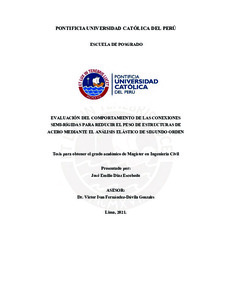| dc.contributor.advisor | Fernández Dávila Gonzales, Víctor Iván | |
| dc.contributor.author | Díaz Escobedo, José Emilio | |
| dc.date.accessioned | 2021-10-15T00:15:02Z | |
| dc.date.available | 2021-10-15T00:15:02Z | |
| dc.date.created | 2021 | |
| dc.date.issued | 2021-10-14 | |
| dc.identifier.uri | http://hdl.handle.net/20.500.12404/20660 | |
| dc.description.abstract | Esta tesis se enfoca a en el comportamiento estructural de cuatro tipos de conexiones Semi-rígidas
Ángulo simple en el alma (SWA), Ángulo doble en el alma (DWA), Ángulo superior e inferior
en las alas (TSFA) y Ángulo superior e inferior en las alas con doble ángulo en el alma (TSFADWA),
para determinar su influencia en el comportamiento de pórticos arriostrados en sus
extremos. Tomando en cuenta el modelo matemático de Hasan, Kishi y Chen (1998) que permite
identificar el comportamiento no lineal de estas conexiones y con la ayuda de un programa en
Matlab, se ha evaluado el comportamiento no lineal de 4832 casos de conexiones con distinta
geometría, cargas y peraltes de viga; estos resultados se presentan el Anexo A. De igual forma se
elaboró otro programa en Matlab que permite ingresar el comportamiento no lineal de la conexión
e incorporarlo al análisis no lineal de toda la estructura, en este caso se evaluaron 360 casos de
pórticos arriostrados con distinta geometría, parámetros sísmicos, cargas y el grado de rigidez de
acuerdo al tipo de conexión. De la evaluación de conexiones se puede decir que, las conexiones
Simples en alma (SWA) resisten el 50% de las conexiones doble en el alma (DWA), las
conexiones TSFA conectadas a las alas de la viga, su resistencia depende más del espesor de los
ángulos que de la longitud, y en conexiones TSFA-DWA el comportamiento es variable, cuando
los ángulos conectados en el alma son esbeltos, su aporte se reduce y el aporte de los ángulos
conectados en las alas de la viga aumenta. Y, de la evaluación de pórticos se concluyó que el
grado de rigidez m = 11 permite reducir el peso de estructuras hasta en 20% y si el grado de
rigidez es mayor a 11, sólo permite reducir el peso de la estructura hasta 22%. Finalmente, se
aplicó el análisis de regresión múltiple con la data recolectada de la evaluación de pórticos para
plantear cuatro fórmulas analíticas que determinan en forma rápida el peso de la estructura, el
momento sísmico transmitido a la cimentación por los arriostres, el drift en el último nivel y el
periodo fundamental con un margen de error de 10%. | es_ES |
| dc.description.abstract | This thesis focuses on the structural behavior of four types of semi-rigid connections Simple angle
in the web (SWA), Double angle in the web (DWA), Upper and lower angle in the wings (TSFA)
and Upper and lower angle on wings with double web angle (TSFA-DWA), to determine its
influence on the behavior of frames braced at their ends. Taking into account the mathematical
model of Hasan, Kishi and Chen (1998) that allows to identify the non-linear behavior of these
connections and with the help of a Matlab program, the non-linear behavior of 4832 cases of
connections with different geometry has been evaluated. , beam loads and superelevations; These
results are presented in Annex A. In the same way, another program was developed in Matlab
that allows entering the non-linear behavior of the connection and incorporating it into the nonlinear
analysis of the entire structure. In this case, 360 cases of braced frames with different
geometry, seismic parameters, loads and the degree of rigidity according to the type of connection.
From the evaluation of connections it can be said that, Simple connections in web (SWA) resist
50% of double connections in web (DWA), TSFA connections connected to the beam flanges,
their resistance depends more on the thickness of the angles than of the length, and in TSFADWA
connections the behavior is variable, when the angles connected in the web are slender,
their contribution is reduced and the contribution of the angles connected in the flanges of the
beam increases. And, from the evaluation of frames, it was concluded that the degree of stiffness
m = 6 allows reducing the weight of structures by up to 20% and if the degree of stiffness is
greater than 6, it only allows reducing the weight of the structure by up to 22%. Finally, multiple
regression analysis was applied with the data collected from the evaluation of frames to propose
four analytical formulas that quickly determine the weight of the structure, the seismic moment
transmitted to the foundation by the braces, the drift in the last level and the fundamental period
with a margin of error of 10%. | es_ES |
| dc.language.iso | spa | es_ES |
| dc.publisher | Pontificia Universidad Católica del Perú | es_ES |
| dc.rights | info:eu-repo/semantics/openAccess | es_ES |
| dc.rights.uri | http://creativecommons.org/licenses/by-sa/2.5/pe/ | * |
| dc.subject | Análisis estructural (Ingeniería) | es_ES |
| dc.subject | MATLAB (Programas para computadoras) | es_ES |
| dc.subject | Pórticos--Análisis de estructuras | es_ES |
| dc.title | Evaluación del comportamiento de las conexiones semi-rígidas para reducir el peso de estructuras de acero mediante el análisis elástico de segundo orden | es_ES |
| dc.type | info:eu-repo/semantics/masterThesis | es_ES |
| thesis.degree.name | Maestro en Ingeniería Civil | es_ES |
| thesis.degree.level | Maestría | es_ES |
| thesis.degree.grantor | Pontificia Universidad Católica del Perú. Escuela de Posgrado. | es_ES |
| thesis.degree.discipline | Ingeniería Civil | es_ES |
| renati.advisor.dni | 06303702 | |
| renati.advisor.orcid | https://orcid.org/0000-0002-1333-8989 | es_ES |
| renati.author.dni | 42295360 | |
| renati.discipline | 732267 | es_ES |
| renati.juror | Zegarra Ciquero, Luis Antonio | |
| renati.juror | Fernández Dávila Gonzales, Víctor Iván | |
| renati.juror | Zeballos Cabrera, Antonio | |
| renati.level | https://purl.org/pe-repo/renati/level#maestro | es_ES |
| renati.type | https://purl.org/pe-repo/renati/type#tesis | es_ES |
| dc.publisher.country | PE | es_ES |
| dc.subject.ocde | https://purl.org/pe-repo/ocde/ford#2.01.01 | es_ES |






